|
In July 1878 Davids Island was made a principal depot of the U.S. Army General Recruiting Service, taking over this assignment from Governors Island. This marked the beginning of the installation’s longstanding mission as a recruitment and training center. With this assignment, the post entered a new phase of growth and development.
Building in Wood
One of the first tasks facing the Army upon its return in 1878 was the provision of housing for the soldiers. Construction soon began on several new frame buildings, including officers’ quarters, barracks and a storehouse. The soldiers continued to use many patched-up and salvaged buildings from the Civil War into the middle 1880s. An inventory from 1881 reveals that of approximately 33 buildings on the post, 15 had probably been built during the Civil War, and at least three others erected in about 1878 were constructed of materials salvaged from older buildings.
With renewed occupation and a clearly-defined role for Davids Island, the Army began to develop the layout of the new post. Its layout was influenced by that of its Civil War predecessor, De Camp General Hospital. The locations of several of the functional areas in the new recruit depot, including the Quartermaster Area, Officers’ Row, Parade Ground, and Barracks Area, derived directly or indirectly from the earlier Army hospital.
In the late 1870s, Col. David S. Stanley and Maj. Samuel N. Benjamin both visited Davids Island and prepared designs for the recruit depot on the island. Their designs rested on the hospital’s layout, which was established in 1862 by the quartermaster responsible for building it, Capt. Robert C. Morgan.
The layout of the recruit depot reflected standard Army concepts of the period about how any post should be organized spatially, with a parade ground at its core adjoined by quarters, barracks, and other key buildings. As at many posts, the idealized vision had to be adapted to the real topographic constraints of a particular site. On Davids Island geographic factors placed the docks (and hence the Quartermaster Area) on the southwestern shoreline. Similarly, the Parade Ground became not a perfect rectangle, but pinched to the east a little in its midsection to follow the crest of the low ridge on which it was situated.
Recruits, Artillerists and Doughboys (1878 - 1922)
19-1894-Oct-Military ReservationMap of Davids Island in 1894, shortly before the post was named Fort Slocum, prepared under the direction of the post's quartermaster, Capt. John W. Summerhayes. 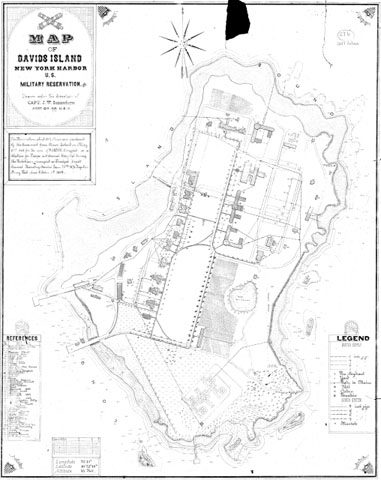  30a - Fort Slocum_1917Quartermaster Corps' map of Fort Slocum, Davids Island, in 1917, showing the more than temporary buildings that had been erected to accommodate extra recruits. 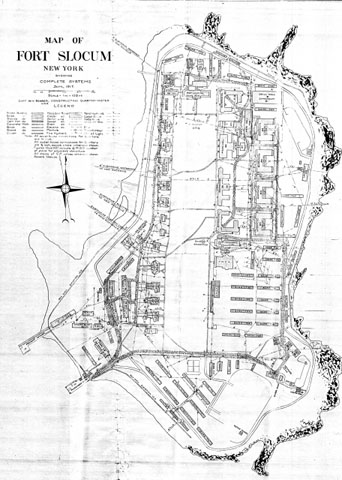  Artillery corpsmen SlocumMembers of an artillery company assigned to Fort Slocum, circa 1898 (collection of the New York Historical Society, Stonebridge Photo Collection, PR 066 358)  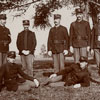 barracks N octagon guard house ca WWIPostcard view of the Guardhouse (Building 56) and one of the barracks (Building 55), circa 1910. 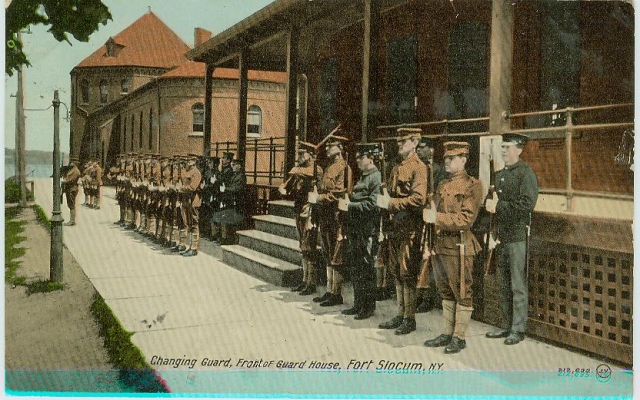  boarding Gen D S Stanley pass dock ggbain LCRecruits departing Fort Slocum from the Passenger Dock during the First World War (Library of Congress, Prints & Photos Div, GG Bain digital collection). 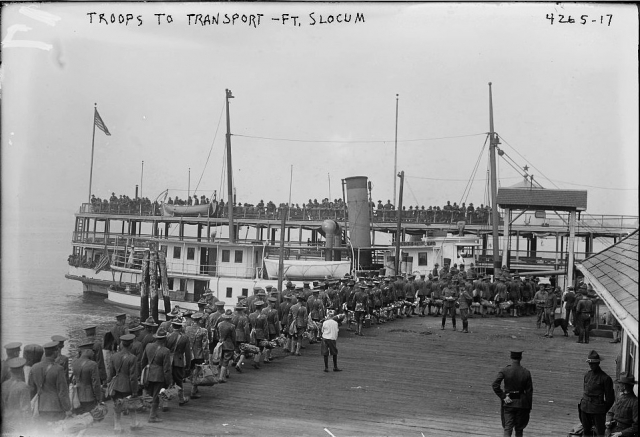  Co B 22 NY Vols firing 1898 Davids IslandRifle practice at the target range on the eastern side of Fort Slocum, 1898 (collection of the New York Historical Society, Stonebridge Photo Collection, PR 066 293). 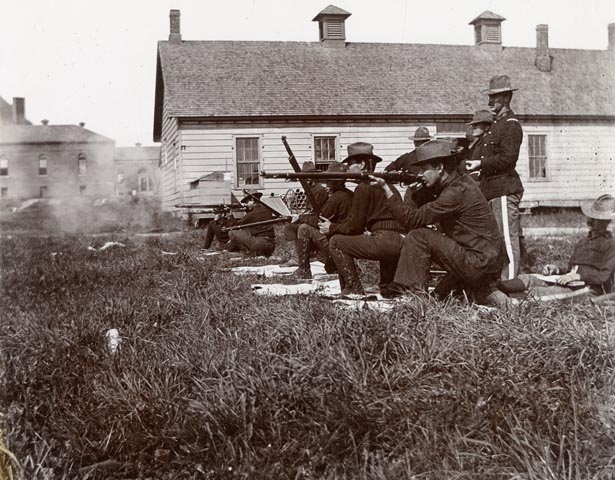  dress parade 16 nov 1904 300 dpi stitchDress parade at Fort Slocum, looking northeast on the Parade Ground, 1904.   Our Quarters pc WWI temporary barracksDuring the First World War, more than 50 temporary buildings were erected at Fort Slocum to accommodate the thousands of extra recruits. 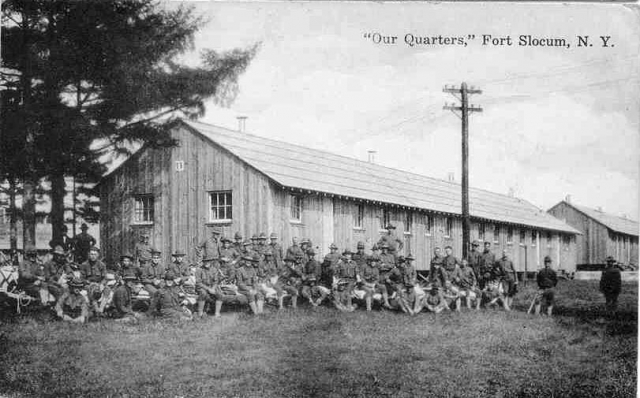  RG 92 Box 5 92-F-19-9 c 1889 wooden barracks inforView of the central and western parts of the Barracks Area circa 1892 showing the mix of wood-frame and brick buildings of the period. 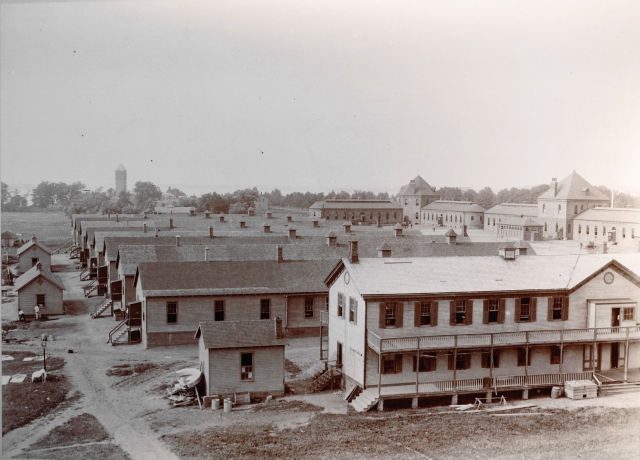  Slocum 2500 Recruits from air ggbain LC2,500 of the more than 140,000 recruits who passed through Fort Slocum during the First World War lined up for this photo (Library of Congress, Prints & Photos Div, GG Bain digital collection). 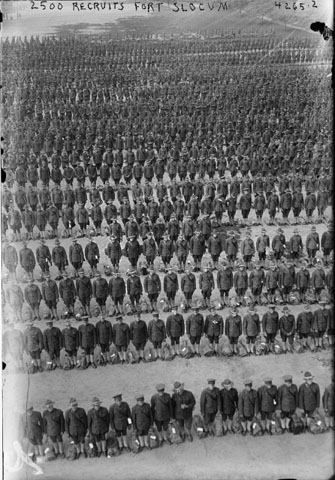  View of Parade pond ice house 92-F-19-2The post on Davids Island, including the Parade Ground and adjoining areas, looking north, circa 1888. 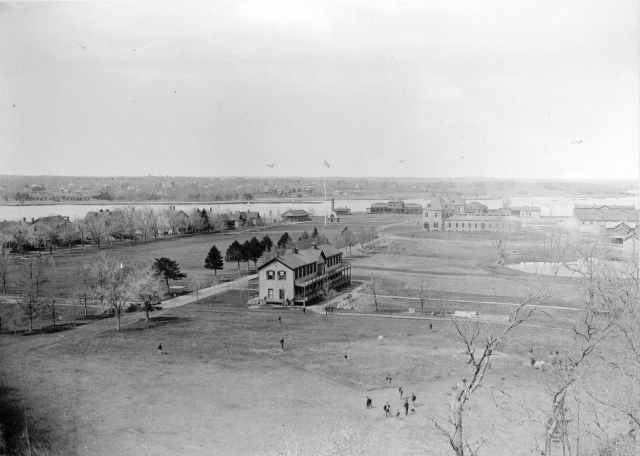 
Building in Brick
As the post on Davids Island grew, the Army gradually invested in new construction, building in wood at first, but by the mid-1880s, beginning to build in brick. The first brick buildings to be constructed on Davids Island included a magazine, a receiving vault, a steam-operated pump house, and a brick water tower, all of which were erected in about 1885. Larger buildings soon followed, including three large brick barracks, and a mess hall and bakery, which were completed by 1889. These four buildings were designed as a group by one of the most innovative quartermasters to serve on Davids Island, Capt. George H. Cook. Except for the pump house (removed before 1902) and the water tower (removed 1929), all of these buildings stood at the post until they were demolished in 2008.
The post at Davids Island served as a principal recruit depot until 1894, when the Army shifted from a centralized to a decentralized system of recruit training. Formerly, all recruits had spent one to three months at a depot for conditioning and initial training before being sent on to their new units. In the system introduced in 1894, new men were quickly dispatched to their regiments, a change that was supposed to increase training efficiency and reduce costs, but proved incapable of doing so.
It was a decade before the Army returned to the earlier recruit depot system. In the interim, recruits continued to pass through Davids Island, but usually stayed for only a few days to a couple of weeks, just long enough for the Army to do a medical examination, complete some paperwork, and issue a uniform and basic equipment.
Meanwhile, Davids Island was also being developed as a coast artillery fortification, and on July 1, 1896, the post was formally named Fort Slocum. Construction of fortifications on the island resulted from the recommendations of the Endicott Board on Fortifications, an 1886 study of America’s coastal defenses. The study called for better protection of the New York Harbor, among other American ports, and Davids Island became part of its system of defenses.
Between 1891 and 1904, artillery batteries were erected at three places on the eastern half of the island—Battery Practice near the southeastern shoreline; the state-of-the-art heavy mortar battery, Battery Haskin-Overton, near the southern end of the island; and two adjoining medium-range gun batteries, Fraser and Kinney, on the northeastern shore. By 1906, the Army had removed all of these fortifications from active service.
The Army built Fort Slocum’s fortifications during the period leading up to and following the Spanish-American War in 1898. The post’s role in that “splendid little war,” as American statesman John Hay called it, was quite limited. It served as the post where the Army’s 7th Artillery was organized and 22nd New York Volunteers encamped for training.
The aftermath of the war was significant for Fort Slocum, because beginning in 1899 it became the East Coast assembly point for soldiers being shipped to American possessions overseas, including Cuba, Panama and the Philippines, which had formerly been under Spanish control. Fort Slocum would continue as overseas recruit depot through the Second World War.
The first decade of the 20th century saw the expansion of Fort Slocum as a facility for recruit intake and as a stateside posting for units assigned to America’s new overseas operations. Between 1905 and 1910, more than 20 new buildings, including officers’ quarters, enlisted men’s barracks, mess halls, hospital buildings, and support facilities, were constructed, and by the eve of the First World War, Fort Slocum had largely acquired the layout and much of the stock of permanent buildings that it had when it closed in 1965.
The First World War
With the onset of the First World War, these new facilities allowed Fort Slocum to become the busiest recruiting station in the eastern United States. It served as the recruit examination station for soldiers from New York, New Jersey, Pennsylvania and the New England states. After training elsewhere these soldiers, popularly known as doughboys, where shipped to France to join the American Expeditionary Force. Between 1917 and 1919, over 140,000 recruits passed through the post. In fact, Recruit Week in December 1917 brought so many recruits to Fort Slocum that an overflow had to be housed in New Rochelle.
Accommodating these personnel necessitated the construction of some 56 temporary wooden barracks and other buildings in several different areas of the post. The Army continued to use the buildings after the First World War for various purposes, such as NCO housing, storage buildings and stables. Most were removed before the Second World War.
|






















 Recruits, Artillerists and Doughboys (1878 - 1922)
Recruits, Artillerists and Doughboys (1878 - 1922)


